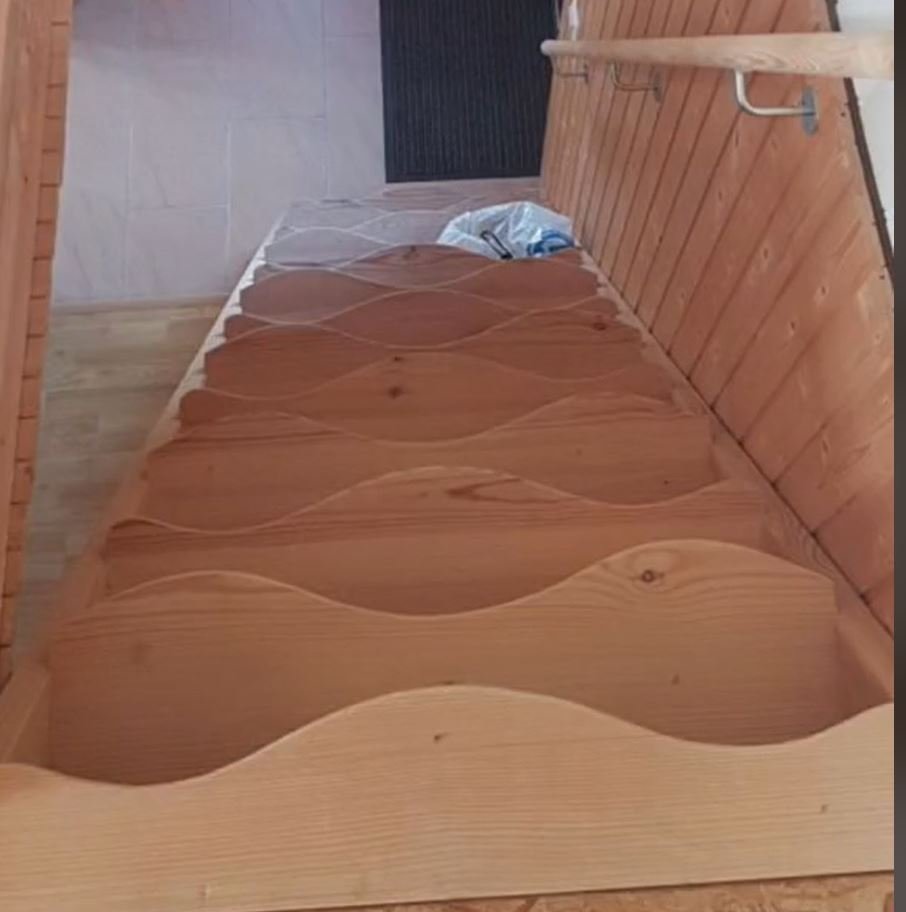Witches’ stairs are a strange but interesting design feature that became popular on TikTok a couple of years ago. Even though they have an unusual history, their name doesn’t really have to do with superstition. Instead, these stairs are a clever design choice. When made and installed correctly, they can be both useful and nice to look at!
Witches’ Stairs aren’t what they Appear.

While the stories about witches’ stairs might sound more interesting, they actually have a very practical purpose. They are really useful in homes with little space, like attics, lofts, and tiny houses. Witches’ stairs are designed to save space while still allowing you to go from one floor to another. Architects often call them “alternate tread stairs.”
How Witches’ Stairs Function

Photo Credit: itsthatrealestatechick | TikTok
Witches’ stairs are designed to save space in two ways. First, each step is only half as wide as regular steps, and the steps are staggered. This makes the staircase narrower than a traditional one. These smaller stairs can also be used for extra storage, like for books or displaying items. According to Scott Schuttner, who wrote “Basic Stairbuilding,” the distance between the steps on one side of an alternating-tread stair is twice the height of the rise, which gives you more space on the steps and makes them safer.
Besides being practical, witches’ stairs meet building codes and safety standards in the U.S. A standard staircase is usually 3 feet wide, while a residential witches’ staircase is typically between 27 and 30 inches wide.
Real Origins

Photo Credit: itsthatrealestatechick | TikTok
In 1985, a businessman named J.M. Lapeyre created a metal version of witches’ stairs. He thought these stairs could be a safe alternative to ladders in commercial and warehouse settings, especially in tight spaces where ladders might not be safe. This design is also used on commercial ships and oil rigs, and it can be called ship stairs or ship ladders, in addition to witches’ stairs and alternate tread stairs.
Misconception

Photo Credit: itsthatrealestatechick | TikTok
When videos of witches’ stairs first appeared on TikTok in 2021, they were linked to an urban legend. According to this legend, these staircases were built in 17th-century Massachusetts to keep witches away during the Salem witch trials because “witches can’t climb up them.” This idea has been proven false, but another rumor suggests that Thomas Jefferson came up with the design. Because of this, witches’ stairs are sometimes called Jeffersonian or Jefferson stairs. However, an original version of the design was also mentioned in a book called “Monckton’s One Plane Method Of Hand Railing and Stair Building,” published in 1888.
Debunking the Myth

Photo Credit: conspiracy___time | TikTok
The exact origins of witches’ stairs are a bit unclear, but one thing is clear: there’s no historical evidence that they were designed to keep witches away. Historian Robin Briggs has studied many historical sources and found no mention of stairs that could disable witches. Interestingly, some people with these unique staircases also buried “witch bottles” or included dead cats in their homes for protection against witchcraft, but Briggs calls this idea “pure disinformation.” He notes that the closest belief was that putting a broom over the door would trap a witch inside.
While it’s fun to think about myths and legends, it’s also interesting to know the real history of witches’ stairs. Regardless, they offer a unique and decorative alternative to regular staircases, adding a fun and quirky touch to home design.
Candace Leslie Cima, 76, is not an ordinary grandma. While she chooses to age gracefully, people often criticize her for her style.

A 76-year-old lady has come under fire for not dressing appropriately for her age.
Candace Leslie Cima showed off her perfect form in a stylish black one-piece swimsuit in response to the criticism, unfazed by it.
She continues to demonstrate that women can still look stunning and stylish at any age, unaffected by the remarks of those who despise them.
Buffalo, New York, native Candace Leslie Cima, 76, is a mother, a businesswoman, a grandmother, a model, and an artist. She gained notoriety for her blog, “Life In My 70s: Aging Is Changing,” where she offered tips on fashion and lifestyle and talked about how women should accept all the aspects of aging that come with it naturally.
Cima claims that she has always been fascinated by the idea of aging and the frequently unfavorable connotations associated with it. In her twenties and thirties, she became interested in the aging process.

She has been a businesswoman for more than 32 years and is the owner of a senior living complex. Cima came to the following conclusion about the years she spent getting to know senior citizens from all backgrounds:
“One thing is certain in my knowledge: aging is changing. Neither our mothers nor our grandmothers are us. We now have the opportunity to live fulfilling lives as stylish, intellectual, caring, and compassionate women far into old age.
In addition to her fame for showing off her stunning looks on her TikTok account, Cima is also well-known for wearing really fashionable and, dare I say, youthful clothing. Even with 94,000 TikTok followers, Cima frequently faces trolling because of the content that she chooses to share.
The gorgeous person receives a lot of flak for wearing clothes that are too big for her age. Nevertheless, the unfazed 76-year-old refuses to let her critics affect her in any way and instead responds by wearing the outfits she desires.
She was spotted wearing an elegant daytime ensemble in a previous TikTok video, which looked like something someone in their late 20s to early 30s may have also worn: an open-toed white stiletto and an edgy pale blue blouse.
A previous critical remark from a viewer stating that Cima shouldn’t be wearing what she is wearing at sixty years old is included in the video’s text. She corrects the viewer while flaunting her skills in the video, shutting down the remark and stating that, in fact, she was 75 years old at the time.
Her reappearance in a TikTok video last year, where she wore a stylish, figure-hugging black one-piece bikini while on vacation in Florida, was another mic-drop moment. Her admirers praised her appearance as they strolled around the poolside area.
Cima’s TikTok social media account was first made to inspire users to get rid of any bad associations with becoming older. She wants to give women the confidence to accept the beauty that comes with aging gracefully and naturally, regardless of their age.
Unaffected by those who have advised her not to wear particular clothes because they are inappropriate for her age, Cima keeps motivating other senior ladies. She often discusses the aspects of aging she enjoys on her blog.
Her favorite aspects of becoming older are being bold, learning to do something new, being less stressed, and having the maturity to accept things beyond her control. Cima believes that growing older might be the best stage of a person’s life:
Many women in their latter years lead active, satisfying lives. Record-breaking and barrier-breaking women are becoming more and more prevalent.

It goes without saying that Cima, who has immersed herself in every aspect of aging, acknowledges that occasionally, older women place restrictions on their own abilities. She is, however, emphatic that other senior women refuse to be moulded or influenced by the discourse that suggests women are incapable of performing certain tasks after a certain age.
Cima claims that as she has aged, she has become increasingly mindful of the ways in which stress and worry impact her. She reveals that while the sensations are inevitable, she eventually discovered via meditation and time management techniques how to balance and improve her connection with her stress and anxiety in order to counteract the harmful bodily impacts of those unpleasant emotions.
Cima is still ignoring the ageist insults that her detractors on social media are spewing at her.
Experience and perspective that come with growing older help to shape a person’s outlook on life. Says Cima:
“Attitude is everything, and your perspective on a subject can alter your feelings toward it. You can alter the result by altering your feelings about it. Growing older doesn’t mean giving up; rather, it means you’ve gained knowledge that, if you so choose, is unstoppable.
Cima’s trim body stands out on its own, even in addition to her eye-catching wardrobe choices. The 76-year-old keeps up her amazing body via regular exercise and fitness.
She demonstrated her amazing yogic abilities while practicing her daily yoga regimen in another TikTok video that she uploaded. Cima demonstrates her extraordinary flexibility by bending and contorting into a variety of forms and stances.
Cima was shown on her yoga mat in the 38-second video, clad entirely in black sportswear. She amazed onlookers, inspiring them to see an elderly woman capable of such feats, from the cat-camel stretch to a full-blown split. One observer made the following comment:
“You are truly an inspiration! As an example of graceful and healthy aging, I have started following a few older ladies on social media at the age of 44.
Cima is still ignoring the ageist insults that her detractors on social media are spewing at her. She never gives up on her mission to encourage women who might not feel at ease in their senior years and to serve as an inspiration to others who are looking for role models.



Leave a Reply